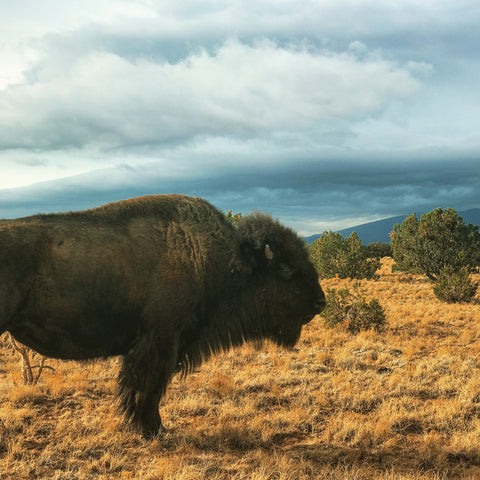Funny you should ask! This is one of the most common questions we get, and we are happy to clarify. Technically, calling a bison a buffalo is inaccurate, but it has been going on for a long time, all the way back to the first trappers and fur traders who explored the American West. According to Wikipedia:
Samuel de Champlainapplied the term buffalo (buffles in French) to the bison in 1616 (published 1619), after seeing skins and a drawing shown to him by members of the Nipissing First Nation, who said they travelled forty days (from east of Lake Huron) to trade with another nation who hunted the animals.[15]
In English usage, the term buffalo dates to 1625 in North America, when the term was first recorded for the American mammal.[16]
The word buffalo is derived from the French “bœuf,” a name given to bison when French fur trappers working in the US in the early 1600s saw the animals. The word bœuf came from what the French knew as true buffalo, animals living in Africa and Asia.[17] The term bison was first recorded in 1774,[18] and is the correct scientific terminology.
Because of this initial confusion, the interchangeable use of the names "buffalo" and "bison" often causes folks to scratch their heads, but we don't worry too much about it. We've been using both since 1947, and if anyone has a problem with it, they can take it up with the fur trappers!
Fun facts:
North American bison have a beard, while their Asian relatives don’t, and American Bison can live in really cold places, like Wyoming!
A buffalo's daily schedule involves two-hour periods of grazing, resting, and cud chewing, then moving to a new location to graze again.
Bison can jump close to 6 feet vertically, and run 35–45 mph when agitated.
Buffalo live in maternal herds, with the oldest and most experienced female leading, with young calves and older animals, including some bulls making up the rest. Mature males live either alone or in bachelor herds, only joining the larger herds at breeding time.
Today, American Bison are thriving due to smart management and breeding efforts and restoration of their native grazing land. By purchasing our free-range, all-natural Buffalo (yes we know...Bison) meat, you are helping to continue a tradition that has been a way of life here in the Mountain West for hundreds of years.



